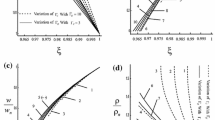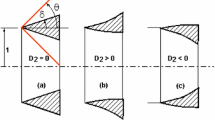Abstract
A simple method is used to determine the curvature of an attached shock wave and the flow variable gradients behind the shock curve at the tip of a straight-edged wedge placed symmetrically in a supersonic flow of a radiating gas near the optically thin limit. The shock curvature and the flow variable gradients along the wedge at the tip are computed for a wide range of upstream flow Mach numbers and wedge angles. Several interesting results are noted; in particular, it is found that the effect of an increase in the upstream flow Mach number or the radiative flux is to enhance the shock wave curvature which, however, decreases with an increase in the specific heat ratio or the wedge angle.
Similar content being viewed by others
References
Hayes, W. D. and Probstein, R. F.: 1966,Hypersonic Flow Theory, Academic Press, New York.
Sedney, R.: 1961,J. Aerospace Sci. 28, 189.
Sharma, V. D.: 1980,J. Aeronaut. Quart. 31, 238.
Sharma, V. D.: 1982,AIAA Journal 20, 1310.
Sharma, V. D. and Shyam, R.: 1984,Acta Astron. 11, 91.
Sternberg, J.: 1959,Phys. Fluids 2, 179.
Taub, A. H.: 1955,Ann. Math. 62, 300.
Thomas, T. Y.: 1948,J. Math. Phys. 27, 279.
Author information
Authors and Affiliations
Rights and permissions
About this article
Cite this article
Singh, L.P., Kumar, A. & Shyam, R. Flow behind an attached shock wave in a radiating gas. Astrophys Space Sci 106, 81–92 (1984). https://doi.org/10.1007/BF00653917
Received:
Issue Date:
DOI: https://doi.org/10.1007/BF00653917




